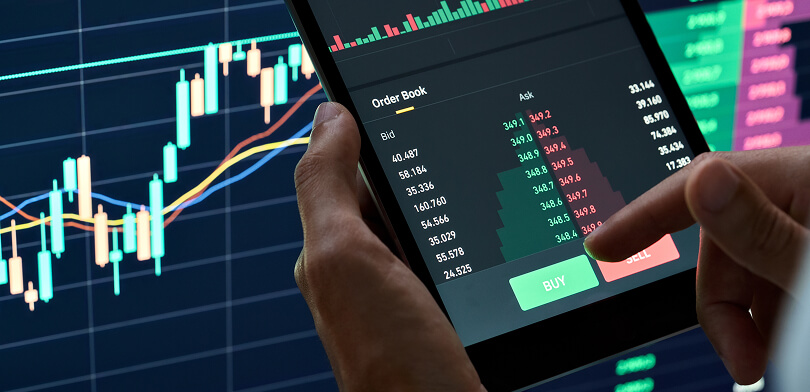Trading can be done randomly by picking any trending stock and waiting to achieve the targets, or you can perform a technical analysis to find the best stock and the right buying and selling levels. Apart from this, there are various techniques of trading that one be unaware of. Quantitative trading is one of them becoming popular among traders.
Topics Covered :
- What is Quantitative Trading?
- Quantitative Trading Example
- Components of Quantitative Trading
- Advantages of Quantitative Trading
- Disadvantages of Quantitative Trading
- Conclusion
What is Quantitative Trading?
Quantitative trading, also known as quant trading, is a strategy for trading that involves quantitative analysis, meaning trade decisions are made based on mathematical computation. The mathematical computation consists of analyzing market data, such as price movement, volume, and other relevant factors, to make better trade decisions.
The price and volume are the key inputs in quantitative analysis of the mathematical models, allowing traders to analyze the stock price and its movement with a better view. Quantitative trading is generally used by hedge fund houses and financial institutions, as they deal with large quantities of trades, like buying and selling shares in high quantities.
However, quantitative trading is now also becoming popular among individual or retail investors. Hence, you also need to understand its various components, how it works, and its advantages and disadvantages to make the best use of quantitative trading.
Quantitative Trading Example
As per the market conditions or stock-related trading strategy and your preferences, you can customize the parameters of quantitative trading algorithms. Suppose you want to trade or invest in momentum stocks; then you can tune your quant model program to select only the stocks that are leading ahead in upward momentum in the markets.
The quant model will pick or buy the stocks that are in upward momentum when the market moves. This is a simple strategy or example of how quantitative trading works. However, it can be adjusted to consider various parameters, from fundamental analysis to technical parameters, to analyze a wide range of stocks as per different market conditions. Quant trading could have unlimited strategies and styles of trading systems.
Recommended Read: What is Trading Volume
Components of Quantitative Trading
Identification of Strategy
The first component of quantitative trading is identifying the strategy, which means you have to plan which strategy to follow based on the market conditions. The strategy identification also involves scrutinizing the possibility of upgrades to adjust trade positions as per changing market conditions and reduce the risk.
Backtesting of Strategy
After identifying the strategy, backtesting of the strategy on system software is another important component to ensure the trading strategy will work for you. When the strategy is applied to the market with hypotheticals and trend-based trading scenarios, the quality is checked to ensure the viability of applying the strategy to actual work. For backtesting, you also need historical data, which involves several input costs.
Execution of Strategy
Executing the strategy is the next component of quantitative trading that is now automated with Algo-based trading software. The right execution helps minimize the cost of transactions that can be high because of brokerage and transaction costs. In quantitative trading, after spending time and effort on mathematical calculations, executing the strategy timely and efficiently is crucial to ensure it gives the best results with the least risk.
Risk Management
Finally, quantitative trading also helps deal with various types of risks involved in trading in the market. Apart from the market risk, it will help you prevent technology-related risks, transaction risks, brokerage risks, and risks associated with your brokers. Quantitative trading helps deal with such risks more effectively and efficiently.
Advantages of Quantitative Trading
Before adopting quantitative trading, you should know how it can benefit you in maximizing your returns from trading and minimizing risk. Let’s find out the advantages of quantitative trading that you can enjoy with such models.
Huge Data Interpretation
One of the biggest advantages of quantitative trading is that it can analyze and interpret a huge amount of data with the potential to reach limitless data points. A normal trader will explore and consider the factors that they are usually aware of, while a quant trader can use unlimited and complex levels of mathematical calculations.
Precise Trade Decisions
Quantitative trading enables traders to make well-informed trade decisions to take the right judgment with effective monitoring and analysis of stock price movement or the trend in the market. It will help you to make more precise decisions to get better results.
Calculative Outcomes
Quantitative trading is based on mathematical calculations and historical datasets that are used to analyze patterns and price movement. With this calculative approach, you can estimate the probability of profitability of your trade positions.
Free From Emotions
As the entire trading mechanism works on a quantitative approach, there is no room for emotions. Quantitative trading is free from human behaviors like emotions, greed, fear, or excitement that can affect trade decisions.
Higher Efficiency
In quantitative trading, computer systems and algorithms operate with lightning speed or perform actions much faster than the traditional way of trading. This quantitative trading approach helps enhance the efficiency of trading.
Better Accuracy
In quantitative trading, the entire procedure is done by computer programs with the help of algorithms, and no human involvement, hence there is no chance of errors. This increases the accuracy of the transactions and improves your overall profitability.
Disadvantages of Quantitative Trading
Require Expertise
To deal with quantitative trading, you need a high degree of knowledge and experience in mathematical calculations, coding, and expertise in extreme market conditions. You should be proficient in every type of market condition and trading strategy.
Lack of Adaptability
The financial markets are highly volatile, and Algo-based trading models used for quantitative trading need to adapt to such volatile market conditions. This could be one of the biggest disadvantages of using quant trading if the model fails to adjust in such market conditions.
Out-dated Models
The quantitative trading models are developed based on historical market data, hence they can sustain or perform based on these market conditions. But with changes in the economic situation, technological development, and other improvements, the market dynamics also change. Hence, the quant models need to be redeveloped or revamped as per the new market conditions, which could be a drawback if the model is not upgraded timely.
Lack of Quality of Data
To develop, revamp, or upgrade quantitative trading models from time to time, you need high-quality datasets that should be free from all types of errors and inaccuracies. The availability of such high-quality datasets to train algorithm models is not easy and also costly, and any inaccuracy in data will have an adverse impact on trade decisions.
Technical Glitches
Technical barriers are another challenge that affects the performance of quant trading software. Sophisticated algorithms and complex mathematical calculations need high-performance computer systems and resources to operate. Any malfunction or technical glitch can badly disturb the entire trading process and performance of quantitative trading.
Conclusion
Quantitative trading typically involves trading strategies based on quantitative analysis consisting of mathematical calculations and algorithm-based computations to analyze market conditions and find the best trading opportunities for traders. It has various components that make it unique and different from the traditional way of trading.
It can interpret and analyze a huge amount of data and perform complex calculations at high speed with high accuracy and zero errors. Quant trading is free from emotions and can help you make trade decisions much faster.
To deal with quantitative trading models, you need expertise and knowledge to handle its various components. And to get the best results, you need to keep your quant models updated and upgraded with the latest trends to avoid glitches and keep performing in varied market conditions. You can use quantitative trading to achieve better profitability in the market.
Recommended Read: How to do the right type of trading in markets

















